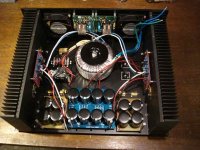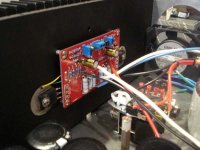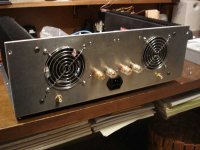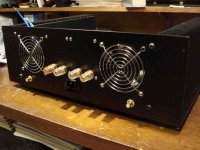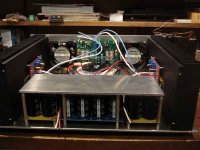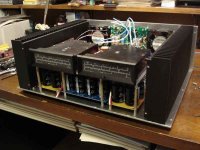All,
With some encouragement from 6L6, here's my version of the F5.
Although my audiophile construction started ages ago, with Dynakit preamps, tube FM tuners, Southwest Tech Products transistor amps and Acoustic Research AR-3 speakers, I haven't been active in the DIY hobby for quite a while.
As a retirement gift (and after a lot of "obvious hints" to my co-workers about building an F5 DIY amp), I received a pair of PCBs to start the effort. Unfortunately, my co-workers are more fans of eBay rather than DIYaudio, and I became the owner of two "dreaded red" PCBs, so my apologies to the other members of the DIYaudio community--and to our mentor, Nelson Pass. I am making amends with donations to the website.
My construction is shown. Nothing very spectacular. I have attened another RC stage to the power supply. Antek transformer, etc. I will be using forced air cooling, via two 120-volt, 90-mm muffin fans, working at 70 VAC to reduce speed, and therefore fan noise. With the reduced speed, I decided to use two fans to compensate for the reduced airflow. The center part of the chassis is a "settling chamber" plenum, which also helps muffle the fan noise (the fans are inaudible from outside the amp). The air flows to the left/right of the chassis, under the heatsinks, and when I add the sides of the cabinet (rosewood panels), the air will be ducted (think cooling chimney) upwards between the fins of the heatsinks, and exit at the top. I'm doing this to match the other components in my system (i.e., wood-sided cabinets). I'm also mounting a thermistor in each heatsink to control fan speed (two-speed design), and ultimately to shut down the amp, if I get into an overheat condition. Since I'm also going to use this chassis as a testbed for other amp and multiple speaker designs, I've added speaker protection circuits; once I'm satisfied with a singular approach, and feel everything is stable, I'll probably remove the protection circuits, and remove the protection relays from the audio path.
I'll also be running two large VU meters (which, unfortunately take up a good portion of the chassis "real estate"). As I get close to final design, though, these may get deleted......)
My chassis is scratch-built from 3/16" aluminum plate. Nice to have access to a friend's milling machine, drill press, etc, for most of the fabrication. I completed the matte black powdercoating yesterday, and did initial final assembly this morning. With that done, I felt "ready for prime time" and sharing some pics on the forum.
Again, I am a "reborn newbie" to DIY construction. As such, I welcome any and all constructive criticism from you'all. Or if you want to "jab me" for going to fan cooling, I'm open to that, too! Again, this site is a great source of info, and I love the forum threads--and yes, I've read all the Nelson Pass articles, on all the related sites(!).
Just pondering--I have an unused Eimac 4CX10000A transmitter tube sitting next to me in my workshop, here. Wondering if it would make a good contender for a Class A amp project....
Ken
With some encouragement from 6L6, here's my version of the F5.
Although my audiophile construction started ages ago, with Dynakit preamps, tube FM tuners, Southwest Tech Products transistor amps and Acoustic Research AR-3 speakers, I haven't been active in the DIY hobby for quite a while.
As a retirement gift (and after a lot of "obvious hints" to my co-workers about building an F5 DIY amp), I received a pair of PCBs to start the effort. Unfortunately, my co-workers are more fans of eBay rather than DIYaudio, and I became the owner of two "dreaded red" PCBs, so my apologies to the other members of the DIYaudio community--and to our mentor, Nelson Pass. I am making amends with donations to the website.
My construction is shown. Nothing very spectacular. I have attened another RC stage to the power supply. Antek transformer, etc. I will be using forced air cooling, via two 120-volt, 90-mm muffin fans, working at 70 VAC to reduce speed, and therefore fan noise. With the reduced speed, I decided to use two fans to compensate for the reduced airflow. The center part of the chassis is a "settling chamber" plenum, which also helps muffle the fan noise (the fans are inaudible from outside the amp). The air flows to the left/right of the chassis, under the heatsinks, and when I add the sides of the cabinet (rosewood panels), the air will be ducted (think cooling chimney) upwards between the fins of the heatsinks, and exit at the top. I'm doing this to match the other components in my system (i.e., wood-sided cabinets). I'm also mounting a thermistor in each heatsink to control fan speed (two-speed design), and ultimately to shut down the amp, if I get into an overheat condition. Since I'm also going to use this chassis as a testbed for other amp and multiple speaker designs, I've added speaker protection circuits; once I'm satisfied with a singular approach, and feel everything is stable, I'll probably remove the protection circuits, and remove the protection relays from the audio path.
I'll also be running two large VU meters (which, unfortunately take up a good portion of the chassis "real estate"). As I get close to final design, though, these may get deleted......)
My chassis is scratch-built from 3/16" aluminum plate. Nice to have access to a friend's milling machine, drill press, etc, for most of the fabrication. I completed the matte black powdercoating yesterday, and did initial final assembly this morning. With that done, I felt "ready for prime time" and sharing some pics on the forum.
Again, I am a "reborn newbie" to DIY construction. As such, I welcome any and all constructive criticism from you'all. Or if you want to "jab me" for going to fan cooling, I'm open to that, too! Again, this site is a great source of info, and I love the forum threads--and yes, I've read all the Nelson Pass articles, on all the related sites(!).
Just pondering--I have an unused Eimac 4CX10000A transmitter tube sitting next to me in my workshop, here. Wondering if it would make a good contender for a Class A amp project....
Ken
Attachments
Papa Pass: As in "two of those" 4CX10000A's....?
Hhhmmm....... If you could come up with the plate transformers, I probably could scrounge a second one....!
After building two such amps, I could probably remove my furnace, and rely upon Rossini to keep me warm during Colorado winters.....!
Hhhmmm....... If you could come up with the plate transformers, I probably could scrounge a second one....!
After building two such amps, I could probably remove my furnace, and rely upon Rossini to keep me warm during Colorado winters.....!
So much heatsink for so little amp...kidding!
Fine work and looks great.
(not crazy about the fans though - are they temp controlled?) - ((never mind - read the posts first John, then respond))
MJL: Agreed--I don't know if I'm a "fan of fans" yet. We'll see how it goes. I was told by a wise audiophile to "hey--just try it, and go with the flow of the river"......
Hum can I scrounge a drawing of the Protection circuit?
Actually, I took the "easy way out" on the protection circuit, so that I could focus on the chassis construction, VU meter drivers, and thermal protection......
I used speaker protections available on eBay:
2x Mono Speaker Protection Module - each for on Channel - eBay (item 300520415532 end time Feb-28-11 08:25:21 PST)
They were $55.00 for the pair.
Others are available (for lower prices) on eBay....just do a search for "speaker protection". (Some of the other eBay adds also include schematics of their circuits).
All, a quick question.....
I start wiring my amp this weekend. Is there a preference for wiring the unbalanced RCA inputs to the amplifier boards?
If I recall a number of the construction photos, I think I've seen both "twisted pair" and coax being used.
Recommendations, and why?
Thanks
I start wiring my amp this weekend. Is there a preference for wiring the unbalanced RCA inputs to the amplifier boards?
If I recall a number of the construction photos, I think I've seen both "twisted pair" and coax being used.
Recommendations, and why?
Thanks
Hello CanAmMan, nice enclosure! Perhaps you could design the circuit so that the fan is only on when it's really bloody hot?!
I've had a twisted pair before, thankfully I was able to fix things myself without a doctors help. Oh wait, that's not what you're talking about. Sorry!
Peace,
Dave
P.S. I'm interested in seeing what kind of amp you can get with a 4CX10000?! Also, where would you get an output transformer?
I've had a twisted pair before, thankfully I was able to fix things myself without a doctors help. Oh wait, that's not what you're talking about. Sorry!
Peace,
Dave
P.S. I'm interested in seeing what kind of amp you can get with a 4CX10000?! Also, where would you get an output transformer?
MJL: Agreed--I don't know if I'm a "fan of fans" yet. We'll see how it goes.
Perhaps you could design the circuit so that the fan is only on when it's really bloody hot?!
I'm talking out of my hat (again), as I'm too lazy to read up on the F5, but a class A amp dissipates maximum heat at idle. That would have the fans running when there is no music to drown them out.
Have you tested to see how hot it gets without them running?
MJL: Once I get my bias set, and I burn in the amp, I will do some heat studies. If worse comes to worse in my "fan concept", I can mill out the bottom of my chassis plate, remove the wood panels, and delete the fans. In doing so, I'd rely upon the Conrad heatsinks to work via convection cooling--just like many of the other F5 clones.
All pending some temperature tests, once I get my amp wired and running.
All pending some temperature tests, once I get my amp wired and running.
MJL: Once I get my bias set, and I burn in the amp, I will do some heat studies. If worse comes to worse in my "fan concept", I can mill out the bottom of my chassis plate, remove the wood panels, and delete the fans. In doing so, I'd rely upon the Conrad heatsinks to work via convection cooling--just like many of the other F5 clones.
All pending some temperature tests, once I get my amp wired and running.
Assuming you are making the stock standard F5 (ie 24V 1.3A) and have conrad mf35-151.5. I can tell you that you won't need the fans. I have biased from 1.3A to 2A using those voltages and the heatsinks are just warm.
What might be worth doing though is rather than removing the fans is put a normally-off thermal switch on the heatsink (eg somewhere between 60 and 70 degree switch) which operates the fans for protection.
Last edited:
What might be worth doing though is rather than removing the fans is put a normally-off thermal switch on the heatsink (eg somewhere between 60 and 70 degree switch) which operates the fans for protection.
Thanks, Melon Head--in fact, that's what I intend to do. I have a fan control circuit going into the amp, that I can set at any reasonable temperaturen and I have thermistors inserted in dimples I've machined in the Conrad heatsinks. I'll play with temps, and set the controller accordingly. When it's all said and done, I may only need it for overtemp conditions.
I don't want to run the MOSFETs too hot, nor too cool--trying to find that sweet spot of bias and temp. (See? I actually HAVE read a lot of the threads, and the Nelson Pass articles!)
Ken
who is Nelson Pass ?

Ohhhhh, Zen Mod...... Tsk-tsk....!!

Right about now, I'm hoping Papa Pass could adopt me...... But I'm pretty certain I'm older than he is!
Thanks for the tip on the twisted pair between the RCA connector and the PCB. I have some very thinnnnnnnnnn solid copper wire I'll use.......
- Status
- This old topic is closed. If you want to reopen this topic, contact a moderator using the "Report Post" button.
- Home
- Amplifiers
- Pass Labs
- Another F5 build--beautiful music, different drummer
